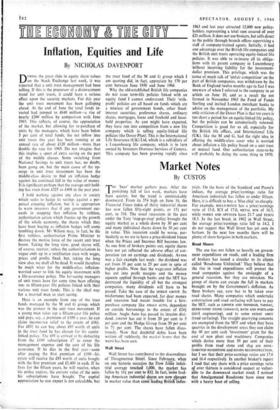Market Notes
By CUSTOS
MHE 'bear' market gathers pace. After the I punishing fall of last week, markets have been quieter, but the trend is unmistakably downward. From its 374 high on June 16, the Financial Times index of thirty industrial shares has now fallen fifty-eight points, or 154 per cent, to 316. The usual recessions in the past under the Tory 'stop-go-stop' policy brought the equity market as a whole down by 30 per cent and many individual shares down by 50 per cent in value. This recession could be worse, par- ticularly as we are to have a price-dividend freeze when the Prices and Incomes Bill becomes law. As one firm of brokers points out, equity shares have not yet reflected the adverse effect of cor- poration tax on earnings and dividends. AVANA was a fair example last week : the dividend was cut from 35 per cent to 25 per cent in spite of higher profits. Now that the wage-cost inflation has cut into profit margins and the money squeeze applied through banks and the SET has destroyed the liquidity of all but the strongest companies, many dividends will have to be passed. Take the case of the HODGE GROUP. Its misfortunes had been expected, for dear money and recession had meant trouble for a hire- purchase company like ANGLO AUTO, dependent on outside borrowings to the extent of £244 million. Anglo Auto has passed its interim divi- dend, GWENT has cut it from 20 Per cent to 5 per cent and the Hodge Group from 30 per cent to 74 per cent. The shares have fallen disas- trously. Now that doubtful debts have been written off ruthlessly, the market hopes that the worst has been seen.
Wall Street Wall Street has contributed to the discomfiture of Throgmorton Street. Since February, when on one historic occasion the Dow Jones indus- trial average touchea. 1,000, the market has fallen by 164 per cent to 83; In fact, some lead- ing American industrial shares are now reaper in market value than some leading British indus- trials. On the basis of the Standard and Poore's indices, the average price/earnings ratio for American industrials has fallen to under fifteen. Here, it is difficult to buy a 'blue chip' so cheaply. For example, ROLLS-ROYCE has a price/earnings ratio of 15.8, ICI of 17.0, METAL BOX of 16.5, while MARKS AND SPENCER have 21.7 and TESCO 18.5. In the last break in 1962 in Wall Street, the average price/earnings ratio fell to 14.2. I do not suggest that Wall Street has yet seen its bottom. In the next few months there will be plenty of share bargains in both markets.
Road Shares The axe has not fallen so heavily on govern- ment expenditure on roads, and a leading firm of brokers has issued a circular to its clients called `Roadstone Unlimited.' They believe that the rise in road expenditures will protect the road companies against the onslaught of a general recession, but they are mistaken. No group of shares can escape the fall in markets brought on by the Governthent's deflation. As these brokers say, care has to be taken over road shares. Many companies which undertake construction and road surfacing will have to pay the SET, such as LIMMER AND TRINIDAD, TARMAC, DERBYSHIRE STONE (AMASCO), BATH AND PORTLAND (civil engineering), and to some extent AMEY (road surfacing). The straight quarrying concerns are exempted from the SET and when they have quarries in the development areas they can claim the 40 per cent cash 'investment' grant for the cost of new plant and machinery. Companies which derive more than 50 per cent of their profits from road stone and slag are AMAL- GAMATED ROADSTONE and ROADS RECONSTRUCTION, but I see that their price-earnings ratios are 17.6 and 16.4 respectively. In another broker's report I read that any share with a price earnings ratio over thirteen is considered suspect or vulner- able to the downward market trend. I noticed that Amalgamated Roadstone have since met with a heavy bout of selling.





























 Previous page
Previous page